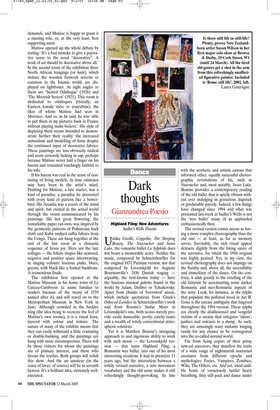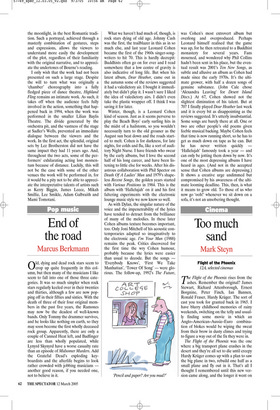Dark thoughts
Giannandrea Poesio
Highland Fling: New Adventures Sadler’s Wells Theatre Unlike Giselle, Coppelia, The Sleeping Beauty, The Nutcracker and Swan Lake, the romantic ballet La Sylphide does not boast a memorable score. Neither the music, composed by Schneitzhoeffer for the original 1832 Parisian version, nor that composed by Lovenskjold for Auguste Bournonville’s 1836 Danish staging arguably, the best-known today — have the luscious musical palette found in the works by Adam, Delibes or Tchaikovsky. Apart from chunks of ‘borrowed’ music, which include quotations from Gluck’s Orfeo ed Euridice in Schneitzhoeffer’s work and from Rossini’s Stabat Mater in Lovenskjold’s one, both scores merely provide easily danceable, pretty, catchy tunes and a wealth of tritely conventional atmospheric solutions.
Yet it is Matthew Bourne’s intriguing approach to and ingenious ability to work with such music — the Lovenskjold version — that turns Highland Fling, a Romantic wee ballet, into one of his most interesting creations. It had its première 11 years ago, but the interaction between a wittily revised narrative, a new movement vocabulary and the old score makes it still refreshingly thought-provoking. In line with the aesthetic and artistic canons that informed other, equally successful choreographic revisitations of his, such as Nutcracker and, most notably, Swan Lake, Bourne provides a contemporary reading of the old ballet that is spicily vibrant without ever indulging in gratuitous slapstick or predictable parody. Indeed, a few things have changed since 1994 and what was presented last week at Sadler’s Wells is not the ‘wee ballet’ many of us applauded enthusiastically then.
The revised version comes across as having a more complex choreography than the old one — at least, as far as memory serves. Inevitably, the rich visual appeal detracts slightly from the biting satire of the narrative, for which the 1994 original was highly praised. Yet, in my view, the revised choreography does not impinge on the fluidity and, above all, the accessibility and immediacy of the dance. On the contrary, it adds greatly to the retelling of the old fairytale by accentuating some darker Romantic and neo-Romantic aspects of the story. Look, for instance, at the sylphs that populate the polluted wood in Act II. Gone is the uneasy ambiguity that lingered throughout the 1994 version. These sylphs are clearly the disillusioned and vengeful victims of a society that relegates ‘aliens’, junkies and outcasts to a dump. As such, they are amusingly scary mutants longing vainly for any chance to be reintegrated into the so-called normal world.
Far from being copies of their prissy tutu-ed ancestors, they manifest the traits of a wide range of nightmarish nocturnal creatures from different epochs and mythologies: Furies, Vampires, Zombies, Wilis, The Others, etc. And yet, amid audible bouts of voraciously lustful heavy breathing, they still pack and dance under the moonlight, in the best Romantic tradition. Such a portrayal, achieved through a masterly combination of gestures, steps and expressions, allows the viewers to understand more easily the development of the plot, regardless of their familiarity with the original narrative, and to appreciate the undertones of Bourne’s reading.
I only wish that the work had not been presented on such a large stage. Despite the will to turn what was originally a ‘chamber’ choreography into a fully fledged piece of dance theatre, Highland Fling remains an intimate work. As such, it takes off when the audience feels fully involved in the action, something that happened back in 1994, when the work was performed in the smaller Lilian Baylis Theatre. The divide generated by the orchestra pit, and the vastness of the stage at Sadler’s Wells, prevented an immediate dialogue between the viewers and the work. In the first act, the splendid, original sets by Lez Brotherston did not have the same impact they had 11 years ago. And, throughout the two acts, some of the performers’ exhilarating acting lost momentum because of distance. Luckily, this will not be the case with some of the other venues the work will be performed in, for it would be a pity not to be able to appreciate the interpretative talents of artists such as Kerry Biggin, James Leece, Mikah Smillie, Lee Smikle, Adam Galbraith and Mami Tomotani.

































































 Previous page
Previous page